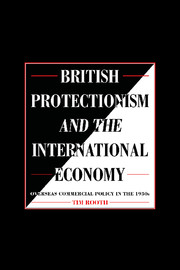Book contents
- Frontmatter
- Contents
- Preface
- List of Tables
- Introduction
- 1 Britain's international economic position in the 1920s
- 2 The political economy of protectionism
- 3 Imperial preference and the Ottawa Conference
- 4 The Scandinavian negotiations: formulation of policy
- 5 Completion of the first phase of negotiations: Scandinavia, Germany and Argentina
- 6 The world economic conference, Finland and Japanese competition
- 7 The Baltic states and Poland
- 8 British agricultural policy and imports during the 1930s
- 9 British exports to the trade agreement countries
- 10 Appeasing Germany and the United States
- 11 Some general conclusions
- Appendix A United Kingdom: payments, clearing etc., Agreements in force 1931–1938
- Appendix B Miscellaneous trade and payments agreements
- Appendix C Imports into Britain from foreign agreement countries
- Appendix D Total exports from Britain to foreign agreement countries and four dominions
- Appendix E Imports of selected commodities into UK, 1931, 1937, showing percentage from Empire sources
- Bibliography
- Index
6 - The world economic conference, Finland and Japanese competition
Published online by Cambridge University Press: 06 July 2010
- Frontmatter
- Contents
- Preface
- List of Tables
- Introduction
- 1 Britain's international economic position in the 1920s
- 2 The political economy of protectionism
- 3 Imperial preference and the Ottawa Conference
- 4 The Scandinavian negotiations: formulation of policy
- 5 Completion of the first phase of negotiations: Scandinavia, Germany and Argentina
- 6 The world economic conference, Finland and Japanese competition
- 7 The Baltic states and Poland
- 8 British agricultural policy and imports during the 1930s
- 9 British exports to the trade agreement countries
- 10 Appeasing Germany and the United States
- 11 Some general conclusions
- Appendix A United Kingdom: payments, clearing etc., Agreements in force 1931–1938
- Appendix B Miscellaneous trade and payments agreements
- Appendix C Imports into Britain from foreign agreement countries
- Appendix D Total exports from Britain to foreign agreement countries and four dominions
- Appendix E Imports of selected commodities into UK, 1931, 1937, showing percentage from Empire sources
- Bibliography
- Index
Summary
By the summer of 1933 the main lines of British commercial policy had been established. The bedrock was the Import Duties Act of March 1932. Within two months of its passage the standard tariff on imports of manufactures had been raised to 20 per cent, and the Import Duties Advisory Committee subsequently recommended additional duties. An inevitable concomitant of protection had been imperial preference, granted to the self-governing dominions on a temporary basis in March 1932 but confirmed and enlarged at Ottawa later that summer. The imperial agreements had still reserved plenty of bargaining power for negotiating other agreements, and by April 1933 the most important of these had either been signed or were well on the way to being completed.
The basic framework of protection and overseas commercial policy was therefore in place by 1933. This still left other issues to be decided, notably agricultural policy, and it still left other treaties to be negotiated, but the point is that they had to be accommodated within the framework already constructed. While the World Economic and Monetary Conference held in London during the summer of 1933 might have provided an opportunity for reviewing policy, perhaps leading to greater emphasis on multilateralism, there is no evidence that it induced any change in the main thrust of British policy.
- Type
- Chapter
- Information
- British Protectionism and the International EconomyOverseas Commercial Policy in the 1930s, pp. 159 - 188Publisher: Cambridge University PressPrint publication year: 1993



